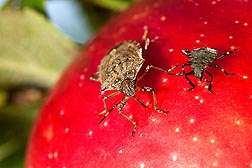ARS scientists test improved stink bug trapping methods

Baited black traps in a pyramid shape attract significantly more brown marmorated stink bugs than other traps, according to U.S. Department of Agriculture (USDA) scientists. Evaluating stink bug responses to different visual stimuli may help manufacturers design better traps for monitoring the bugs.
Entomologist Tracy Leskey at the Agricultural Research Service (ARS) Appalachian Fruit Research Station in Kearneysville, W.V., focused on visual stimuli that can attract the stink bugs to traps that will help farmers monitor the level of infestation in their fields and orchards.
ARS is USDA's principal intramural scientific research agency, and this research supports the USDA priority of promoting international food security.
In field trials in 2009 and 2010, Leskey and her colleagues found that significantly more stink bug adults and juvenile bugs, called nymphs, were captured in the baited black pyramid traps than in other traps. The researchers also found that more adults and nymphs were captured in a trap placed on the ground than in a commercially available trap hung from a tree limb.
These prototype pyramid traps may serve as monitoring tools to assess the presence, abundance and seasonal activity of pests and natural enemies to determine the need for insecticide applications.
Leskey and her colleagues also found that in 2010, 2011 and 2012, stink bugs produced two generations in one year in Kearneysville, based on the presence of eggs and newly molted adults in field cage experiments. Although it has been reported that these bugs produce only one brood annually in eastern Pennsylvania, it appears that in more southerly locations within the Mid-Atlantic region, they can produce two generations per year, according to Leskey.
Results from 2010 were published in the Journal of Entomological Science.
A more extensive study is being replicated in several states on the East Coast to determine how many generations may be produced annually in those locations.
More information: Read more about this research in the January 2013 issue of Agricultural Research magazine: www.ars.usda.gov/is/AR/archive … n13/stinkbug0113.htm
Journal information: Agricultural Research
Provided by United States Department of Agriculture

















